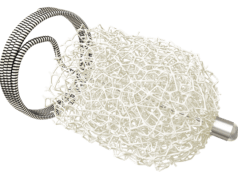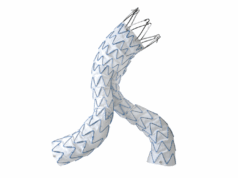
Results of a randomised controlled trial (RCT) point to the beneficial effects of a community-based exercise programme on outcomes in patients with an abdominal aortic aneurysm (AAA).
Researchers Adam Haque (Manchester University NHS Foundation Trust, Manchester, UK) and colleagues found that a patient-directed, community-based exercise programme significantly improved the cardiopulmonary exercise testing (CPET) parameters associated with impaired perioperative and long-term survival in patients following AAA repair. They observed that the improvements were maintained at 12 weeks following the end of the programme.
In an article published online ahead of print in the European Journal of Vascular and Endovascular Surgery (EJVES), the authors note that ruptured AAA carries a mortality rate of up to 80%. They state that elective repair prevents rupture, however perioperative mortality remains at 2–3%. “This mortality, and long-term survival, is associated with impaired peak oxygen uptake (peak VO2), oxygen uptake at anaerobic threshold (AT) and ventilatory equivalent for CO2 at AT (VECO2) on CPET,” Haque et al explain. “Improving fitness to optimise these variables could improve perioperative and long-term survival, but the required exercise training suitable for AAA patients, has yet to be established,” they write. The investigator’s AAA Get Fit prospective RCT aimed to evaluate the effectiveness of 24-week, patient-directed, community-based exercise on CPET-measured fitness in AAA surveillance patients.
Haque and colleagues report that they randomly assigned patients on AAA surveillance at a tertiary UK vascular centre (n=56) to either a 24-week community exercise programme (CEP) with choice of gym or home exercises or standard clinical care including advice on weight loss and exercise. They assessed the primary outcome of change in peak VO2 at 24 weeks, and secondary outcomes including AT, VECO2, cardiovascular biomarkers, body mass index (BMI) and health-related quality of life. Follow-up was conducted at eight, 16, 24 and 36 weeks.
The authors reveal in the EJVES that the CEP patients (n=28) achieved mean (95% confidence interval) improvements from baseline in peak VO2 of 1.5 (0.5, 2.5), 2.1 (1.1, 3.2), 2.3 (1.2, 3.3) and 2.2 (1.1, 3.3) ml/kg/min at eight, 16, 24 and 36 weeks, respectively. “These changes in CEP patients were significantly greater than those seen in controls at 16 (p=0.002), 24 (p=0.031) and 36 weeks (p<0.001),” they add. In addition, Haque et al observed “significant” improvements in AT, triglyceride levels and health-related quality of life in CEP patients.
According to the investigators, the AAA Get Fit trial has a number of limitations. They state, for example, that peak VO2 at baseline was “significantly greater” in controls than in CEP patients, which occurred despite minimising on randomisation for peak VO2 more or less than 15ml/kg/min—i.e. equivalent to the threshold associated with perioperative survival. “What effect this would have on the patients’ ability to improve their fitness is open to conjecture,” Haque and colleagues remark.
Haque et al also recognise that patients who agree to take part in research “tend to be more motivated than those that refuse”. They note that, although both recruitment and attrition rates were “better than that achieved by previous research on exercise training in AAA patients,” the majority of patients (61.2%) declined to take part. “Efforts to improve this rate would need to be made to maximise effectiveness in clinical practice,” the authors acknowledge, however they stress that it is “difficult to explore specific reasons” behind the low rate of uptake, as there were no significant differences in demographics between those that did and did not agree to take part.
In addition, the authors raise the question of how such an exercise programme would be implemented within the confines of a public health system such as the UK National Health Service (NHS). Despite the barriers to implementation posed by such a system, including funding, resources and patient compliance, Haque and colleagues believe the proposed patient-directed and community-based exercise training programme is one that should be cheaper and easier to deliver for large populations compared with traditional hospital-based supervised exercise. In addition, they note that this approach encourages patients to exercise at a location and time convenient to them, which “should improve compliance”.
Considering the impact of this RCT, Haque et al anticipate that the results “should now inform definitive multicentre RCTs with the aim of investigating the effect of improving CPET parameters with CEP on all potential clinical outcomes in AAA surveillance patients, including perioperative morbidity and mortality, cardiovascular risk, health-related quality of life and all-cause mortality”. Such studies, they add, would also need to include robust cost-effectiveness analyses and “may ultimately provide evidence to support the widespread implementation of CEP to improve outcomes for all individuals with AAA”.













